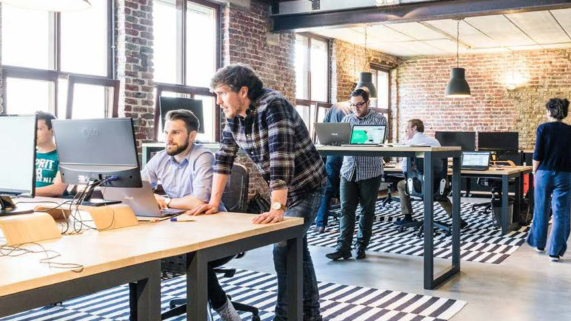This comprehensive guide will cover more than ten different methods that companies use to measure office utilization – from old fashion surveys to modern occupancy sensors. To download a PDF version of the guide, click here.
Today, occupancy sensors are the most effective way to measure utilization. Occupancy sensors are electronic devices that can detect motion and recognize when a room is occupied. Sensors today do far more than turn off the lights when you leave the room. Sensor products include established technologies such as infrared, ultrasonic, microwave, photoelectric, camera-based, microphone, and pressure-based sensors. These sensors are being integrated with other technologies, including the Internet of Things (IoT), Artificial Intelligence (AI), and Machine Learning (ML), to offer new tools for facility managers, real estate, retail, and human resources. These technologies measure human occupancy and determine how employees and guests interact with the space and the objects around them.
The Internet of Things (IoT) allowed occupancy sensors to become more versatile and can be connected to a variety of other devices, systems, and applications. For example, connected occupancy sensors can monitor occupancy levels in a room or space, trigger alerts when a certain occupancy level is exceeded, and provide data that can optimize energy efficiency by turning off lights and the HVAC system. They can also trigger other automated activities, such as opening and closing doors, alerting personnel, or even alerting the fire department during an emergency.
Sensors are typically mounted to the ceiling of an area and connected to the internet. Many look like smoke detectors. These sensors can provide analytical data so that these spaces may be better utilized while managing the space, lights, HVAC, and assets. This results in an improved employee experience, additional safety, increased workplace productivity, and improved costs and asset utilization. The post-installation studies I have performed help validate these improvements with energy savings at the forefront.
This chart compares the capabilities of the different office space utilization methods:
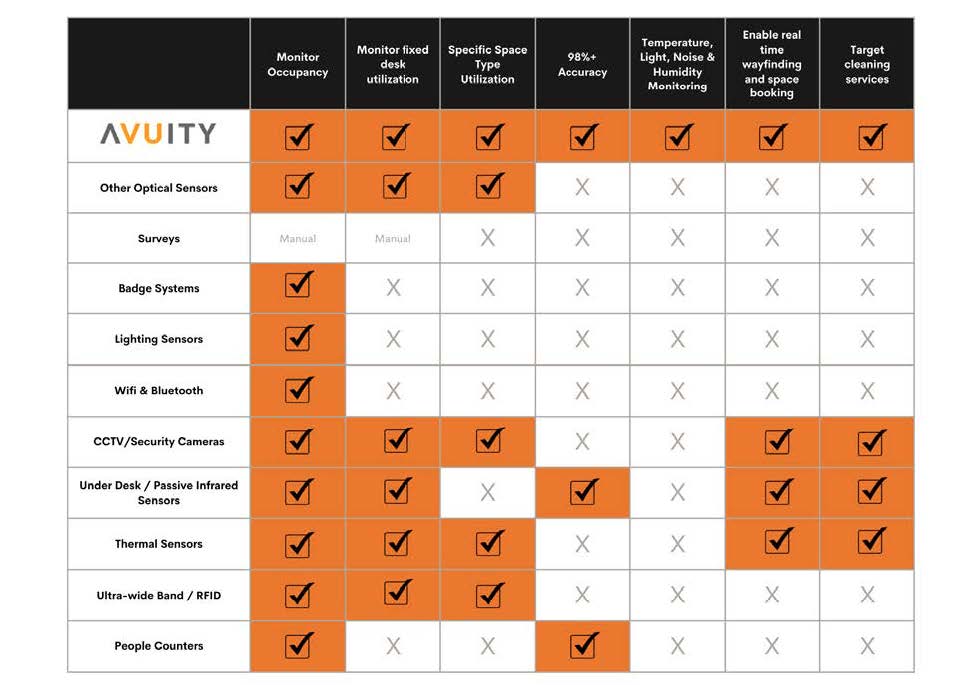
Let’s dive further into each method for measuring your office space utilization rates, and discuss the pros and cons.
Surveys
How it works
Corporations have used surveys to measure space utilization for decades. From simple questionnaires handed out to employees, to “Space Surveys” where a notetaker walks a space on different days of the week at different times noting what spaces are in use.
Pros
- Captures the emotional component including how people feel about the space in which they work
- Can capture the way people use the space, beyond just whether the space is in use. Example: using the phone, on a video call, etc.
Cons
- Provides only a short snapshot in time measurement. Building a long-term, time series data set would be prohibitively expensive.
- Human data collection is susceptible to many shortcomings
- Employees may change their behavior when they know a survey is being taken
- Surveys can be very difficult to compare across regions or cultures
Badge swipe systems
How it works
Data is collected via a badge or turnstile system that counts the number of people entering a space. Typically measured at the building’s entrance or security gate, but may also occur at elevator banks or at the entrance of secure areas.
Data from employee swipe badges or security passes can be collected at access points like building lobbies, security gates or elevators to count the number of occupants in a building or floor.
Pros
- If there is a badge system in place, this data is typically easily accessible.
- Simple and fast indicator of the number of people that enter a building any day
- Cam measure team by team utilization as the data includes personally identifiable information.
Cons
- Only collects aggregate level data. There will be no understanding around the use of specific types of space.
- Tailgating (following someone into the building without swiping a badge) can materially impact data quality
- Most buildings or areas do not require badging out, therefore limiting the ability to understand how long someone spends in the office.
- Many buildings include multiple tenants and turnstile entrances may not differentiate between the different tenants.
Lighting Sensors
How it works
Motion detectors understand if there is motion in a space to turn on the lights. Some of these sensors will also report back how often motion was detected as an indicator of how often the space is in use
Pros
- Lighting sensors are standard as part of most major office specifications.
- These sensors tend to be very reasonably priced.
- These sensors can be deployed in virtually all types of spaces.
Cons
- The data collected is not very detailed. There is no distinction between the number of people or how a space is being used. This is exacerbated in open areas as small amounts of motion are detected in big areas.
- Many landlords supply lighting in areas occupied by tenants, so accessing the data can be troublesome
WiFi & Bluetooth Tracking
How it works
WiFi & Bluetooth tracking are grouped together because they both measure the number of connected devices in a space. They work by measuring the when and where devices are connecting to the network in your office.
Pros
- Low cost if using existing network devices and connections
- May not require additional hardware
Cons
- Data has significant ability to be skewed as employees may not want their cell phone being drained via constant bluetooth pings or may turn off their computer in meetings. These both result in understating occupancy and utilization.
- Does not include occupancy or utilization of space by visitors or anyone that is not connected to the network.
- While more detailed than badge swipes, the data collected can be ascribed to a specific floor and potentially even a portion of the floor, but not to a specific space. These systems are usually accurate to a 50 foot area.
Smart CCTV/ Security Cameras
How it works
Certain security camera systems can perform people counting or even facial recognition using computer vision.
Pros
- Relatively easy and cheap to install if there are already security cameras covering the space where you are looking to collect occupancy and utilization data.
- The most advanced systems are quite accurate
Cons
- Many of these systems require access to the actual video stream, creating privacy and security concerns.
- The employee experience can suffer significantly when there are security cameras in every room. It is atypical for security cameras to be deployed across the full office footprint, though are typical at entry/exit points.
Passive Infrared Sensors (or under desk sensors)
How it works
Passive infrared sensors (PIR) sense motion in an area via looking at a change in temperature in an area.
When used at a desk, the sensor sits on the underside of the desk and when it detects heat, it makes the desk as being in use. The data is then processed via a cellular network and delivered to a gateway where it can be passed to a software application.
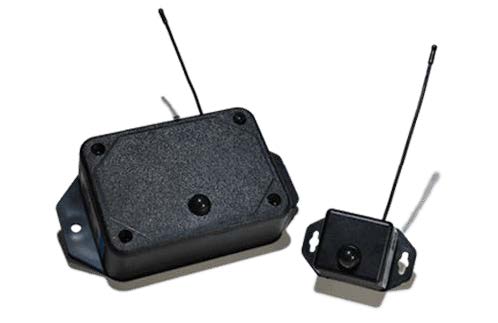
Pros
- Each sensor is reasonably cheap
- Easy to install
- A good solution for phone booths or other single person spaces.
Cons
- Every seat needs a sensor. While other solutions can monitor multiple seats at the same time, PIR sensors can only monitor one seat at a time.
- Employees tend to reject sensors on their desk and regularly remove the sensor if there is not proper communication around why the sensor is there and what it does.
- These sensors are not useful in open areas such as collaboration spaces or cafeterias, gyms etc. Because the sensors are required to be affixed to a piece of furniture, they are only useful for that specific piece of furniture.
Thermal Sensors
How it works
Thermal sensors use heat and computer algorithms to determine the probability that an object is a person.
These sensors work by effectively having a grid where each section has a temperature reading. Then the sensor understand the occupied and unoccupied temperatures inside the grid to build an understanding of occupancy.
Pros
- These sensors do not capture any personally identifiable information (“PII”)
Cons
- Sensors have a relatively short range of less than 30 feet, which can be made even shorter if there are obstructions (i.e. furniture) that obscure the reading of the sensor.
- There are lots of things that give off heat in an office setting (i.e. laptops), which can result in inaccurate data.
Ultra-Wide Band Systems (UWB Sensors +Tags)
How it works
UWB sensors work by having a transmitter and a receiver. Employees carry the transmitter, which may be integrated into an employee identification card, that communicate to receivers that have been deployed across the floor.
Pros
- Location accuracy is very high – down to the inch level in many cases
- Has the ability to understand each person’s journey while in the office
Cons
- Requires employees to carry the tag with them at all times.
- Likely to miss visitors to the office as they do not carry the receiver
- Large deployments of receivers (each floor requires dozens) can be complicated and expensive
RFID Occupancy Systems (RFID Sensors +Tags)
How it works
RFID deployments are similar to UWB but represent an older technology. Employees have an RFID tag on their badge or identification.
Pros
- Cheaper than UWB
Cons
- Less accurate than UWB – identify the number of people in an area, but not in specific spots.
- Similar to UWB it requires every employee to carry the receiver.
People Counters
How it works
People counters are deployed ingress/egress points and count the number of “ins” and “outs” from a space. There are a number of different types of underlying technology for people counters including PIR, computer vision, trip beams, etc.
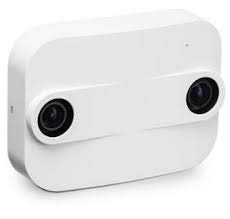
Pros
- More accurate than badge swipes as it eliminates the “tailgating” problem
- Does not require anything from employees (no badge swipes or connecting to wifi)
- Anonymous
Cons
- Error rates (and pricing) vary widely by technology.
- Susceptible ot cumulative error. Missing one count early in the day skews the count of people throughout the day.
- Only give aggregate counts of people in a space. No ability to understand how people use a space. Example: If deployed at an elevator bank, these sensors can give the count of people on the floor, but not what spaces they used on that floor.
- Limited field of view requires the deployment to be right at a doorway and unlikely to be accurate across a hallway.
Computer vision or optical sensors
How it works
Computer vision sensors apply an algorithm over an image to understand what types of things are included in the image. The outputs of this algorithm inform a software application of how space is used. These sensors can be either battery powered or cabled.
Pros
- No obligation for employees to do anything
- Can provide highly detailed analysis of how a space is being used with accuracy down to the seat level
- Sensors can be deployed permanently with consistent over the air software upgrades
Cons
- Coverage of each sensor limited by obstructions including walls, so each room requires a sensor.
- Coverage area varies by provider
- Installations require additional hardware and a contractor being onsite
Sensor Applications
With an integrated platform that includes Data analytics and AI utilization, there are several applications for these sensors, including:
- Lighting operation and optimization, including daylight harvesting
- Optimize cleaning and maintenance costs
- Monitor occupancy, provide headcounts, and perform door counting
- Space and desk utilization, space booking
- Monitor whole office utilization
- Way-finding and space booking
- Social distancing reporting, health, and safety
- Entry systems
- Optimize real estate portfolios
- Measure environmental metrics (temperature, humidity, sound, and lighting)
- Monitor desk and asset utilization, including measuring objects and workplace tools
- Integration with energy management systems, including HVAC systems optimization and sustainability
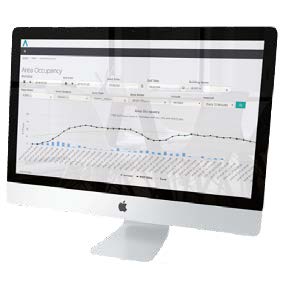
How to Choose a Sensor Platform for Your Company
There are a plethora of sensor companies, so how do you choose?
Choosing the appropriate sensors for your business depends upon your present and future applications. Do you want to control lighting and HVAC, or do you need sensors that collect data on workplace utilization and occupant behavior and see when the coffee room is utilized? Implementing the Internet of Things (IoT) sensors coupled with powerful analytic programs allows you to optimize the workplace. Businesses have begun to realize the value of occupancy sensors. The question that you should ask is: “What do we require from the sensors?”
An integrated platform should include the following:
- Workplace Analytics
- Interactive wayfinding maps
- A system that locates available spaces and helps you best utilize your space?
- A system that maintains anonymity?
- A platform that utilizes machine learning and artificial intelligence to measure and optimize:
- Human occupancy
- Environmental metrics (temperature, humidity, sound, lighting)
- Objects and workplace tools
Choosing The Right Sensor Company
Look for a proven industry leader and trendsetter. One that develops and manufactures the sensor hardware and the software necessary to capture and manage key analytics working on the edge of technological innovation.
AVUITY is an industry leader and independent technology firm continually growing to meet and exceed our clients’ needs.
We offer a range of sensor options to fit your needs, whether your needs are for incremental studies or full-time space measurements.
If you wish to set your company up for future success and invest in technology to measure the performance of your space, then contact us today for a free consultation.

